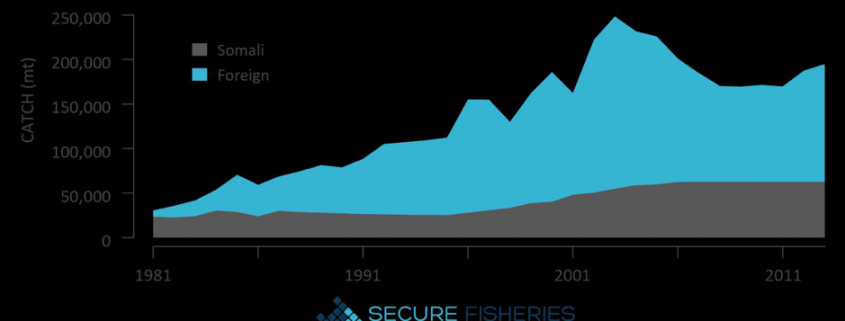Securing Sustainable Somali Fisheries
By Peter Aronson, SRC intern
Lots of people know about the issue of piracy in Somali waters in recent years, with mass coverage from American media and even Hollywood focusing on it with the 2013 movie Captain Phillips. However, many people don’t know that the loss of secure fisheries to illegal foreign vessels was the root cause of these conflicts (Beri, 2011). In the 1980’s, when the Somali Civil War first broke out, the central government collapsed and the Somali Navy disbanded. As a result, foreign fishing boats took advantage of the lack of security and fished Somali waters heavily, leading to great erosion of fish stocks. With no government intervention to help, artisanal Somali fishermen banded together to protect their own resources. At first, violence was not threatened or used. However, as events escalated, weapons were used, both poor fishing vessels and wealthy cargo vessels were taken over, and in some cases hostages were held for ransom. As this became profitable, pirate activities became widely funded by financiers and militiamen on land. The cause of all this was illegal foreign fishing.

Illegal, unreported, and undocumented (IUU) fishing from foreign fleets declined in Somalia in the mid 2000’s due to piracy, but increased again when foreign naval fleets began patrolling Somali waters to reduce piracy (Oceans Beyond Piracy, 2014). Seeing foreign fleets off the coast angered the public and increased support for piracy, as sustainably developing artisanal and subsistence fisheries became much more difficult with pressure from foreign operations. Due to uncertainty of the legality of foreign fishing for decades, unregulated fishing with ineffective enforcement of decades-old policy, and catch that hasn’t been reported to the United Nations since 1988, there is a widespread perception that any foreign fishing activity in Somalia is illegal (Glaser et al., 2015).
Apart from poor fisheries management, there is justified anger towards foreign vessels due to violent conflict. They have been accused of hiring armed guards to shoot at Somali fishers, blasting hot water at Somalis, and destroying fishing gear in domestic artisanal fisheries (Glaser et al., 2015). Additionally, Somalis are upset at the foreign fleets’ destruction of fish stocks at the expense of domestic fishing, and using destructive methods, such as bottom trawling, that destroy coral reef and other habitat. As a result, Somalia has removed fishing rights from many foreign vessels, and have even captured vessels and imprisoned the fishermen aboard them (Glaser et al., 2015).

Using satellite data, the Secure Fisheries group with the One Earth Future Foundation estimated the amount of foreign fishing vessels in Somali waters between 1981 and 2013, and the amount of fish they took. It was estimated that 3.1 million metric tons of marine life was taken in this time frame by foreign vessels, more than twice the amount that domestic Somali fishermen took at 1.4 million metric tons. The heaviest fishing nations in the time frame are Iran, Yemen, Spain, Egypt, and France, though in 2013 Spain, Seychelles, France, South Korea, and Taiwan dominated.
Trawling has had a great impact on Somalia’s marine habitat. Trawling from foreign nations continued for decades following the collapse of Somalia’s government, with bottom trawling even continuing beyond Somalia’s ban of it in the new Somalia Fisheries Law. It was mainly Italian and Egyptian vessels trawling until 2006, when South Korean ships replaced the Italian ones. Italian and Korean vessels fished 220 and 229 days of the year respectively. Some trawlers are actually licensed to Puntland, a coastal region in Somalia on the Horn of Africa. Due to its wide continental shelf and high fish availability, as well as licensing in the region, most trawling occurred in shallow waters here. Over the time period that data was collected, 120,652 square kilometers were trawled, an area slightly larger than the neighboring nation Eritrea (Glaser et al., 2015). This doesn’t account for areas of seafloor that were trawled multiple times. Several areas that experienced this underwent significant ecosystem damage.
In Somalia, foreign fleets are larger, better equipped, and more technologically advanced, giving them a competitive edge over smaller Somali vessels. Globally there is a similar trend of large, distant, industrial fleets outcompeting small, artisanal and subsistence fishers. These small-scale fishers are some of the world’s poorest people and are extremely vulnerable to changes in resource availability (Béné, 2009). The current sustainability of fish stocks were estimated by Secure Fisheries using methods designed for data-poor fisheries. It was found that 8 of 17 fish groups analyzed are currently fished unsustainably, including swordfish, emperors, sharks, snappers, and groupers. This data must be used cautiously, as categories were analyzed at different levels, such as striped marlins at the species level, to sharks at the family level. Additionally due to little available data, estimations of migratory species used catch reconstruction and the classification of whether or not a stock was sustainable was based on comparison to an exact calculated value.

Optimistically, a lower proportion of fish stocks are being fished unsustainably in Somalia than globally, and no stocks are collapsed whereas 24% of stocks are globally. This advantage is due to delayed industrial fishing in Somali waters. However, if trends continue and follow the preceding global pattern, it is estimated that over half of Somali stocks will be overexploited by 2025 (Glaser et al., 2015). It is important to move towards sustainable fisheries in Somalia. With the full effects of postcolonialism pressing down on the nation, sustainable fisheries could promote the Somali economy, provide food, and nourish many for years to come.
Works Cited
Béné, C. (2009). Are Fishers Poor or Vulnerable? Assessing Economic Vulnerability in Small-Scale Fishing Communities. Journal of Development Studies, 45(6), 911–933. doi:10.1080/00220380902807395
Beri, R. (2011). Piracy in Somalia: addressing the root causes. Strateg. Anal., 35 (3), 452-464.
Glaser SM, Roberts PM, Mazurek RH, Hurlburt KJ, and Kane-Hartnett L (2015) Securing Somali Fisheries. Denver, CO: One Earth Future Foundation. DOI: 10.18289/OEF.2015.001
Oceans Beyond Piracy. (2014). The State of Maritime Piracy Report 2014. Denver, Colorado: One Earth Future Foundation.



